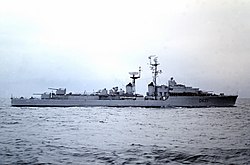French-built ships
Fleet Escorts – (Escorteurs d'escadre)

- T 47 class (Surcouf class)
- Surcouf (D621) 1955–1972
- Kersaint (D622) 1956–1984
- Cassard (D623) 1956–1974
- Bouvet (D624) 1956–1982
- Dupetit-Thouars (D625) 1957–1988
- Chevalier Paul (D626) 1957–1971
- Maillé-Brézé (D627) 1957–1988
- Vauquelin (D628) 1956–1986
- D’Estrées (D629) 1957–1985
- Du Chayla (D630) 1957–1991
- Casabianca (D631) 1957–1984
- Guépratte (D632) 1957–1985
- T 53 class
- Duperré (D633) 1957–1972
- La Bourdonnais (D634) 1958–1976
- Forbin (D635) 1958–1981
- Tartu (D636) 1958–1979
- Jauréguiberry (D637) 1958–1977
- T 56-class destroyer – single ship modified for ASW testing
- La Galissonnière (D638) 1962–1990
Fast Escorts – Escorteurs rapides

- Type E50 (Le Corse-class) frigate:
- Le Corse (F761) 1955–1975
- Le Brestois (F762) 1956–1975
- Le Boulonnais (F763) 1955–1976
- Le Bordelais (F764) 1955–1976
- Type E52 (Le Normand-class) frigate:
- Le Normand (F765) 1956–1983
- Le Picard (F766) 1956–1979
- Le Gascon (F767) 1957–1977
- Le Lorrain (F768) 1957–1976
- Le Bourguignon (F769) 1957–1976
- Le Champenois (F770) 1957–1975
- Le Savoyard (F771) 1957–1980
- Le Breton (F772) 1957–1976
- Le Basque (F773) 1957–1979
- L'Agenais (F774) 1958–1985
- Le Béarnais (F775) 1958–1979
- Type E52B:
- L'Alsacien (F776) 1960–1981
- Le Provençal (F777) 1959–1981
- Le Vendéen (F778) 1960–1982
Sloop Escorts – Avisos escorteurs

- Commandant Rivière-class frigate
- Victor Schœlcher (F725) [note 4] 1962–1988
- Commandant Bory (F726) [note 5] 1964–1996
- Amiral Charner (F727) [note 6] 1962–1990
- Doudart de Lagrée (F728) [note 7] 1963–1991
- Balny (F729) [note 8] 1970–1994
- Commandant Rivière (F733) [note 9] 1962–1984
- Commandant Bourdais (F740) [note 10] 1963–1990
- Protet (F748) [note 11] 1962–1992
- Enseigne de Vaisseau Henry (F749) 1963–1996
Coastal Escorts – Escorteurs côtiers


- Le Fougueux class
- Le Fougueux (P641) 1954–1975
- L'Opiniâtre (P642) 1954–1975
- L'Agile (P643) 1954–1976
- L'Adroit class :
- L'Adroit (P644) 1957–1979
- L'Alerte (P645) 1957–1979
- L'Attentif (P646) 1957–1978
- L'Intrépide (P630) 1958–1976
- L'Ardent (P635) 1958–1979
- L'Etourdi (P637) 1958–1976
- L'Enjoué (P647) 1958–
- Le Hardi (P648) 1958–1977
- L'Effronté (P638) 1959–
- Le Frondeur (P639) 1959–1977
- Le Fringant (P640) 1959–1982